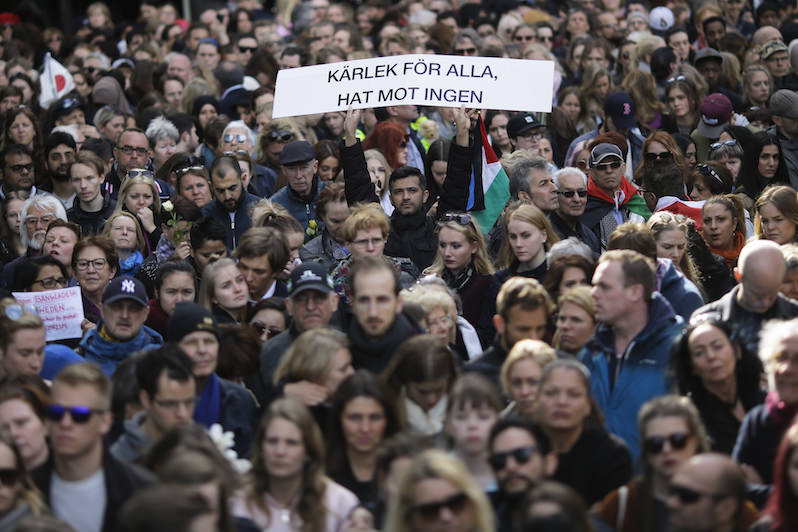Yes, Sweden Is a Paradise Lost—but Not Because of Immigration
In a whirlwind of rumors, Sweden has come to occupy a central role, cast as the innocent, naive, white country in the North that has collapsed because of its own goodness. Thousands of people attends a "Lovefest" vigil against terrorism in Sergels Torg, central Stockholm, on April 9, days after a hijacked truck drove into a crowd of pedestrians April 7, killing four. The poster in the center reads: "Love for everyone -- hate toward no one." (Markus Schreiber / AP)
Thousands of people attends a "Lovefest" vigil against terrorism in Sergels Torg, central Stockholm, on April 9, days after a hijacked truck drove into a crowd of pedestrians April 7, killing four. The poster in the center reads: "Love for everyone -- hate toward no one." (Markus Schreiber / AP)
Back in February, when President Trump referred to a terror attack in Sweden that never occurred, the whole of Sweden was bewildered. What was he talking about?
Yet it wasn’t the first occasion in recent times that Sweden has found itself the object of racially-tinged rumors. In December, a story made the rounds in U.S. press about Sweden banning Christmas lights “To Avoid Offending Muslim Migrants.” Seeing Christmas lights outside of my window and all over my city—Stockholm, the capital of Sweden—I couldn’t figure out who could believe such an absurd idea. It turned out that in some small villages in the southern county of Småland, authorities had clamped down on individuals overloading the public lamppost cables with their own Christmas lights, thereby causing damage.
Then there was the time a Swedish drug addict fell asleep inside the church of Kristianstad with his penis out. This became raw material for a story about hordes of Muslim refugees “defecating and masturbating” inside a Swedish church.
The Swedish daily newspaper Dagens Nyheter discovered a fascinating fact about the latter two stories: both originated from a “troll factory” in the former Yugoslavian republic of Macedonia. There, hundreds of young men make a living inventing stories designed to spread like wildfire on social media—in order to generate clicks for advertisers. The man who invented the church story, Ivan Stankovic, earned $25 for it, which he considers a jackpot.
Fake news is now a capitalist industry where a story serves merely as bait to drag customers to an ad. American consumers’ clicks are the sought-after product of this industry, and anything that might stir Americans’ indignation, curiosity or fear is worth gold. Firms like Facebook provide the platform. Young, unemployed men of Eastern Europe do the work, and advertising companies reap the profits. It goes without saying that a Ghanaian or Cambodian click is not worth as much as an American click. A Ghanaian or Cambodian might read the story, but do not possess the same consumer power to buy the products adjacent to it. To generate clicks, all means are allowed, as long as an American’s eyes will fall on the advertisement.
And what generates clicks nowadays? Stories about Muslims taking over the world.
In this new whirlwind of rumors, Sweden has come to occupy a central role. It is cast as the innocent, naive, white country in the North, which once was a paradise, but which has collapsed under its own goodness. A typical headline in the U.K. newspaper, The Telegraph, reads: “How Sweden, the most open country in the world, was overwhelmed by migrants.” Swedish people are cast as good-hearted, stupid liberals who want to save the world but end up being taken advantage of by evil immigrants who rape, plunder and subject everybody to their own religious faith.
There is also a gender dimension of this myth, with stories of rape and sexual harassment playing a crucial role. These stories work especially well because Sweden has a reputation as a sexually liberated country where equality between men and women has made significant advances.
In the paranoid racist narrative, Sweden is therefore symbolized by a woman who has dared to venture too far from her white man, refusing him as head of household and castrating him psychologically. Instead, she is shown—heaven forbid!—holding up a “Refugees welcome” sign. She is now being “punished” for her openness by gang rape, sexual harassment and the soon-to-come law that will mandate that all Swedish women wear burkas.
Interestingly enough, this myth has two dimensions. It is used both to show that immigrants are in Sweden to take the white man’s women (which bears similarities to the rationale behind lynchings of young black men like Emmett Till in the U.S.) and that the sexually liberated woman deserves to be punished. It suffices to read the comments under videos in which rape is discussed, such as “Islamic Rape Wave in Sweden” or “Sweden; Muslims, Murder, Rape, Welfare, and Our Future! A Must-See,” to see that many right-wing extremists don’t pity said rape victims—they actually gloat about them. Comments such as “These sluts deserve it” and “Swedish men are gay” are intertwined with “Kill all immigrant parasites.” In a strange way, these white men actually use Muslims and African immigrants as a weapon against white women. “If you don’t shut up and obey me, the immigrants will come to rape you and I won’t be there to defend you.”
Another dimension of this narrative is a covert anti-socialist, anti-welfare punchline: Sweden is being destroyed because its social democratic welfare state has been too generous.
Why Sweden, one might ask. Sweden is, after all, the European country that has perhaps been the best at integrating immigrants. According to the 2011 British Migrant Policy Integration Index, or MIPEX study, “Swedish integration policies offer favorable conditions for migrants to participate in society” and “Sweden’s score of 83 gave it the highest rank among countries included in the study. Portugal ranked second with a score of 79, followed by Canada.”
These findings have now been disputed by other studies, but to argue that mayhem reigns in Sweden is untrue. Sweden is the 17th richest country in the world, with a GDP surpassing that of Germany and France and an unemployment rate of 7 percent compared to the EU average of 8.5 percent. If there really was chaos and misery due to immigration, this would likely have had an effect on the economy.
If any country has been overwhelmed by migrants, it would be Lebanon. A total of 1.2 million Syrian refugees have taken shelter in this small country of 4.4 million inhabitants, giving it the highest per capita concentration of refugees in the world. Obviously, this doesn’t go unnoticed, and the U.N. has warned there is a danger the country could implode if the Syrian refugee crisis is not well managed. Or, why not Turkey, with 2.5 million Syrian refugees? But to cast Lebanon or Turkey as the protagonists in the story wouldn’t have the same effect. After all, this myth is about the white race under attack from dark people, the Muslim threat to Christianity and the demise of the “West” in general. And to cast a colonial power such as France or Britain in the role of the “innocent victim of immigration” when history still reeks of their atrocities—no.
Sweden has, however, historically held a special place in the heart of the Nazis: Hitler claimed that the purest stock of Aryans was found in Sweden and Norway.
So what about the real Sweden behind the myth?
Being born and raised in Stockholm and having lived half my life in areas that racists refer to as “no go zones,” I can say that these places are nothing like it. They do not come near the average American’s notion of a ghetto, and have nothing of the misery one sees in France or Belgium. I have never felt unsafe in Stockholm or in Malmö at any time of the night. Violence is not increasing—rather the opposite, in a 20-year perspective.
Nor do we have a “rape wave.” The fact that reported rapes rose between 2004 and 2005, from 25.2 per 100,000 inhabitants to 41.9 per 100,000 inhabitants—compared to 10.4 in Austria—has been used to “prove” almost anything about Sweden. First it was used by the sex industry’s allies who claimed men raped more because paying for sex was banned. Then it was used by Julian Assange’s supporters, who took it as proof that Sweden was a “ ‘hornets’ nest of revolutionary feminism” where a man could be accused of rape for almost anything. Then it was used by white supremacists who took for granted that all these rapists were immigrants.
The truth is, Sweden’s rape statistics cannot be compared to those of other countries because of Sweden’s definition of rape. In France, if a man rapes a woman 50 times, this counts as one rape; but it would count as 50 rapes in Sweden. Since 2005 in Sweden, sex with a minor (under 15) is classified as rape, as is sex with an unconscious drunk person, or a person who is asleep. We have also had numerous campaigns by the women’s movement to encourage women to report rapes. In comparison, Nicaragua and Qatar do not have a single case of reported rape the past year, which hardly can be taken as proof that rape doesn’t exist in those countries.
Yet, the idea of Sweden as a “paradise lost” is not entirely wrong. But this has little to do with immigration.
Sweden was, until the mid-1980s, the country with the most equality between the sexes—due to the welfare system that our slanderers blame for everything. Nowhere else in the capitalist world were income differences so small. The Gini coefficient was 0.2 (a measurement of the income distribution of a country’s residents), and unemployment was around 1 percent. Due to our geographic and geopolitical location between the Soviet bloc and the west, we’ve had a mixed economy, one which combines socialist and capitalist traits. Large public ownership of key sectors, subsidized housing, free health care, and relatively high taxes coexist with successful private companies that have gone multinational: Ikea, Volvo, Saab, Ericsson and Alfa Laval.
With the fall of the Soviet Union in 1991, Sweden’s politics took a drastic neoliberal turn. Most notable was the change within the Social Democratic party, which now turned 180 degrees and started following the New Public Management doctrine. Mass privatization ensued. Electricity, housing, pensions, telephone, railways, public transport, health care, pharmacies, even schools passed from public to private. In most of these cases, the public companies were well-functioning and trusted by the majority of the population.
Since the 1990s, taxes have been reduced, step-by-step, for the richest segment of the population, causing income differences to skyrocket. Sweden is now the country where economic inequality is growing the fastest in the Organisation for Economic Co-operation and Development. After Sweden joined the EU in 1994, labor rights were dismantled and unions came under heavy pressure to accept worse conditions or see their factories move. Class struggle now had a new opponent: the EU Court, which ruled that foreign companies had the right to operate in Sweden and pay salaries low as they would pay in their country of origin.
At the beginning of 2010, every tenth Swedish company had moved part of its production abroad. Combined with heavy cuts in public welfare, this led to rising unemployment, which hit some towns especially hard. Added to that, loosened border controls and a bridge between Sweden and Denmark built in 2000 made heavy drugs much more available; cocaine flooded the market. Housing construction subsidies were abolished and public housing, previously owned by the state or city council was sold out to private companies, leading to an extreme rise in private debt and a scarcity of available apartments.
While the Swedish upper-middle-class benefited from lower taxes and made money off the housing bubble, the lower segment of the working class has not seen incomes rise for over 20 years. “New poverty” has become a concept referring to parents who were unable to buy their children essentials like eyeglasses or proper winter clothing. The term “white trash,” previously alien to us, was suddenly imported from the U.S. to label the new poor.
Yet the people who found themselves at the very bottom of the socio-economic ladder were not Swedes, but immigrants. Immigration to Sweden is not a new phenomenon, having started in the 1960s with so-called “guest workers” from Greece, Turkey and Yugoslavia, followed by political refugees from Chile in the 1970s, from Iran in the 1980s and from the former Yugoslavia in the 1990s. In the new millennium, Sweden has mainly hosted refugees fleeing U.S. imperialist wars or consequences of imperialist involvement—Iraq, Somalia, Afghanistan and, most recently, Syria. While the U.S. closes its doors to citizens of these countries, Sweden has opened them. There are more Iraqis and Syrians in Sweden than in the whole of the U.S. Despite often having higher education, many of the newcomers filled up job sectors including house cleaning, taxi driving, and restaurant work, causing Swedes who previously held those jobs to move up the ladder. Often employers use a lack of language skills to cheat newly arrived workers of their contracts and other rights.
The widening class gaps have thus acquired an ethnic dimension. The Southern European immigrants who came to work for Volvo in the 1960s also faced racism and prejudice, but this never became a political issue because there was no material conflict. Now Swedes believe they’ve been robbed of a middle-class future, and the country’s economic situation looks ever more dog-eat-dog.
We compete with each other for jobs, houses and schools for our children. Everyone is blaming everyone across the spectrum—Swedes blame immigrants, old immigrants blame newcomers, women blame men, the rich blame the poor and so on. Since we do not use cars to the same extent as Americans do, to live in the inner cities is a privilege reserved for the upper classes. In the near suburbs resides the middle class, and the further out you go, the more unemployment rises. In some suburbs, unemployment is as high as 25 percent. Sweden’s cities are not segregated the way American cities are—we don’t have Chinatowns, Muslim or Italian areas. Rather neighborhoods are segregated by class, which means poor Swedes and poor immigrants from all over the world live in the same areas.
So there is new poverty, yes. There are class gaps, yes. There is frustration, yes. But there is no ethnic war going on. There are no areas where one cannot go—so-called “no go zones”—and there definitely aren’t zones ruled by Sharia law. In the week after the truck attack in Stockholm that killed four people, my city has shown a sense of community, solidarity and strength which is atypical of Stockholm (or so the rest of Sweden thinks). Swedes and immigrants have stood together, helped each other and gathered in masses to mourn the victims. Those who claimed the terrorist attack would lead to hatred and division have been proven wrong.
Your support matters…Independent journalism is under threat and overshadowed by heavily funded mainstream media.
You can help level the playing field. Become a member.
Your tax-deductible contribution keeps us digging beneath the headlines to give you thought-provoking, investigative reporting and analysis that unearths what's really happening- without compromise.
Give today to support our courageous, independent journalists.






You need to be a supporter to comment.
There are currently no responses to this article.
Be the first to respond.